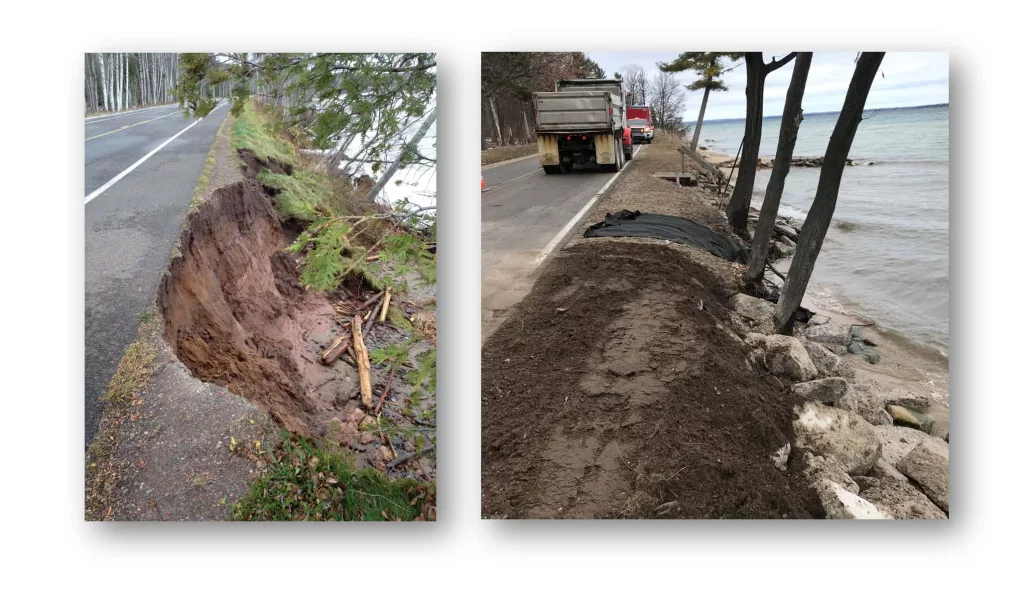The tab to resolve high water erosion damage along county roads in Michigan is rapidly approaching $40-million and climbing. That’s the word from the County Road Association of Michigan which has been assessing the damage from high water issues throughout the Great Lakes. The current bill for road restoration sits at $37.4-million.
Berrien and Van Buren Counties are two of the hardest hit in all of Michigan, appearing on the association’s list of the 10 counties in the state where damages are topping $1-million, with Berrien’s estimate topping $2-million and Van Buren’s tally north of $1.5-million.
The County Road Association of Michigan recently released estimated damage figures to county road infrastructure caused by high water levels on the Great Lakes, having compiled the data after surveying the 41 county road agencies with Great Lakes shoreline. County road agencies are responsible for 75-percent of Michigan road miles, including the typical 33 feet right-of-way on each side of the centerline to support and drain the road.
Denise Donohue, CRA Executive Director, says, “As a participant in Governor Whitmer’s much-needed Great Lakes High Water Level Summit this winter, CRA has worked with counties to pull together this data,” and adds, “We know there are many challenges facing the State of Michigan currently, but by summer Michigan residents will be eager to get out on the roads visiting Michigan’s most scenic and popular dunes and beaches.”
Donohue notes, “Our county road agencies will have the roads safe and ready for the driving public but there may be detours and closed road sections due to Great Lakes high water damage,” and adds, “If the federal government issues a major infrastructure funding package, using some of it to protect against high water damage to roads makes sense.”
CRA’s data shows that of the 38 responding counties, their engineering staff peg the damage at $37.4 million currently. The damage is reported in 133 locations and totals 16 miles of pavement or right-of-way that require immediate restoration. The total impact on the county road system rises to 73 miles when considering intersection-to-intersection detours around those locations.
About 22-percent of road agencies said they would need to purchase additional right-of-way in 77 different locations to stabilize the roadbed, and 8.5-percent said permanent road relocation totaling six miles is likely required.
Brad Kluczynski, Manager of the Grand Traverse County Road Commission, reports, “Based on our engineer’s visual inspection, we are estimating $2,250,000 in repair costs for the work needed to stabilize the road and right-of-way,” adding, “On April 2nd, an additional 100 feet sheared off of Bluff Road on Old Mission Peninsula, and this could continue happening.”
He adds, “If Lake Michigan rises substantially higher, there will likely be additional sections that need to be addressed – including possible closure of a segment of the popular Bluff Road that runs along Old Mission Peninsula to our wineries and other agricultural and tourist destinations.”
Kluczynski says, “One section of Bluff Road was already closed this winter due to erosion that reached the edge of the driving surface and we have another dead-end spur off of Forest Avenue that was formerly a gentle slope into the water and is now a steep drop-off that may need to be closed for safety reasons.” He concludes, “We won’t know until we can get into the water to investigate.”
In the Upper Peninsula, tourism and access to some of Michigan’s most iconic sites are also threatened by high Great Lakes water levels.
Mike Maloney, PE, Engineer-Manager of the Ontonagon County Road Commission, says, “County Road 107 is the only access from the east into Michigan’s largest state park, the Porcupine Mountains Wilderness State Park including Lake of the Clouds and the ski slopes,” adding, “The east side is where the majority of the park’s 450,000 visitors enter.”
Maloney reports, “CR 107’s erosion is and will continue to have severe impacts to the community and the Michigan Department of Natural Resources,” and notes, “While we were unsuccessful in getting a federal BUILD Grant, we have secured the assistance of the Michigan National Guard and the Michigan Department of Natural Resources (MDNR) to restore 1,700 feet of shoreline this summer.”
The County Road 107 – also known as the 107th Engineers Memorial Highway – project has already cost OCRC (which has an $8 million annual budget) $800,000 including $200,000 from the MDNR in a project that begin this winter. Maloney pegs the fix at $5 million, although relocating the road further from Lake Superior at $13 million is the preferred fix.
The 83 members of the County Road Association of Michigan represent the unified voice for a safe and efficient county transportation infrastructure system in Michigan, including appropriate stewardship of the public’s right-of-way in rural and urban Michigan. Collectively, Michigan’s county road agencies manage 75-percent of all roads in the state, including 90,000 miles of roads and 5,700 bridges. County road agencies also maintain the state’s highway system in 64 counties. Michigan has the nation’s fourth-largest local road system.
In the photos accompanying this story on Moody on the Market are shown:
On the left: County Road 107, the only access from the east into Michigan’s largest state park, the Porcupine Mountains Wilderness State Park, has been seriously damaged by Lake Superior.
On the right: Bluff Road, which runs along Lake Michigan on Old Mission Peninsula to wineries and other tourist destinations, has been seriously compromised by high water levels in Lake Michigan.






